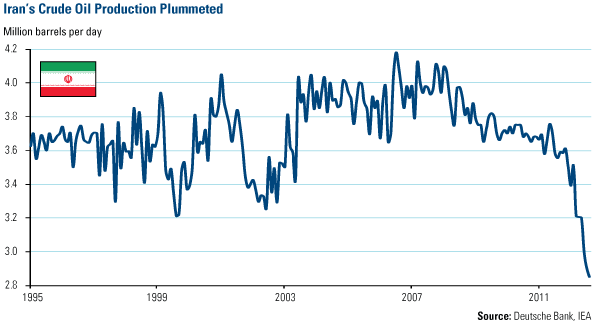Energy and Natural Resources Market (October 1, 2012)

Strengths
- Natural gas jumped 14 percent this week to the highest level this year as concern eased that stockpiles will reach storage limits before winter weather boosts demand for the heating fuel. Weekly Department of Energy data showed inventories increased by 80 billion cubic feet to 3.576 trillion in the most recent week while peak working gas capacity is about 4.239 trillion, department data shows. The futures have rebounded 73 percent from a 10-year low in April as rising power-plant demand eroded the biggest supply glut in six years.
- U.S. farmers maintained their record pace of harvesting corn and soybeans during the past week but farmers were not fully running their combines due to some rainy weather.
Weaknesses
- Dow Jones reported that Anglo American, the world’s third-largest producer of coking coal, plans to reduce coking coal output in the coming months as it reviews its existing operations and projects due to weak coal prices and high costs.
- Baoshan Iron & Steel Co., China’s largest listed steelmaker, suspended production at a plant after demand fell for slabs used to make ships and bridges. “A downturn in demand in the downstream slab market” prompted the stoppage, the company said in a statement to Shanghai’s stock exchange yesterday, without elaborating on when production may resume. Production was suspended “to avoid increasing our operating losses,” it said.
Opportunities
- The People’s Bank of China (PBOC) has injected a record amount of money into the financial system this week to alleviate short-term liquidity concerns. The PBOC issued Rmb365 billon of reverse repurchase agreements over the past three days, the largest weekly amount in history. The cash inflow was effective immediately, causing the seven-day repurchase rate to fall 100 basis points from the three-month high of 4.75 percent reached earlier in the week.
- The Financial Times reported that South Africa would allow “fracking” in what could potentially be the fifth-largest shale gas reserves in the world and provide a major boost for energy, jobs and reduced pressure on coal production. South Africa has lifted its two-year moratorium on fracking; now all it needs is to find the water for the process in the Karoo desert. European nations that host shale gas are perhaps hoping that successful development of South Africa 's gas will encourage work in their countries.
Threats
- The Financial Post reports that “When the Fukushima nuclear disaster unfolded in March last year, even the most optimistic investors knew the uranium market was in for a rough ride - they just didn't think it would last so long. Eighteen months after the incident, uranium prices continue to hit new lows. The spot price sunk 50 cents to $46.50 a pound this week, which is the lowest level since 2010, according to Ux Consulting. Investors briefly drove the spot price above $135 in 2007. The long-term price has also declined, though it is higher at $60, reflecting the fact buyers will pay more for material delivered mid-decade or later.”












